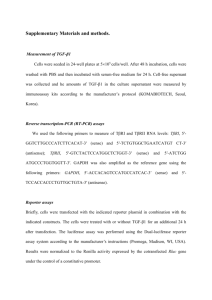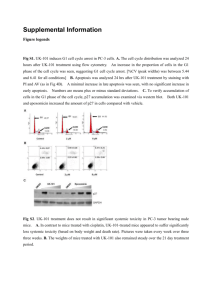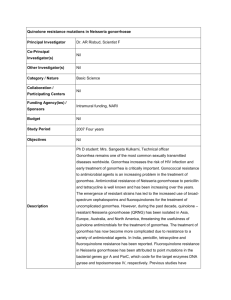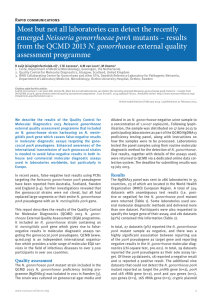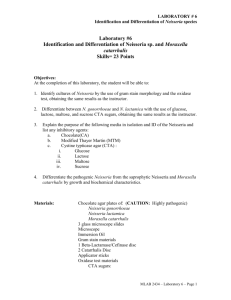Supplementary Methods (docx 27K)
advertisement
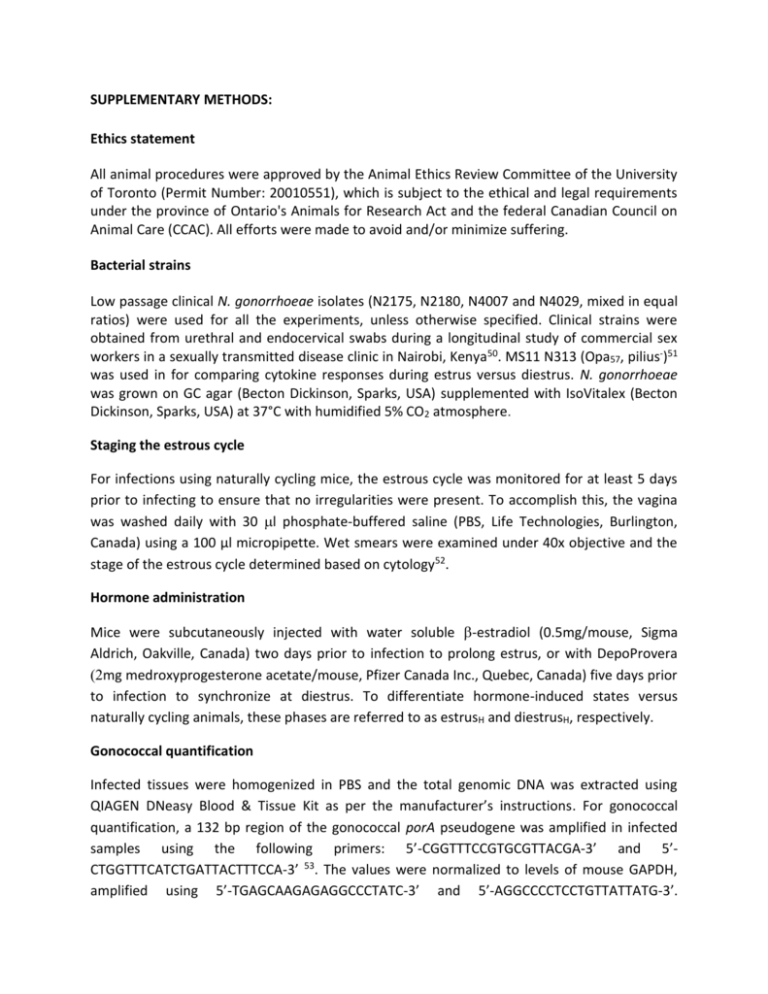
SUPPLEMENTARY METHODS: Ethics statement All animal procedures were approved by the Animal Ethics Review Committee of the University of Toronto (Permit Number: 20010551), which is subject to the ethical and legal requirements under the province of Ontario's Animals for Research Act and the federal Canadian Council on Animal Care (CCAC). All efforts were made to avoid and/or minimize suffering. Bacterial strains Low passage clinical N. gonorrhoeae isolates (N2175, N2180, N4007 and N4029, mixed in equal ratios) were used for all the experiments, unless otherwise specified. Clinical strains were obtained from urethral and endocervical swabs during a longitudinal study of commercial sex workers in a sexually transmitted disease clinic in Nairobi, Kenya50. MS11 N313 (Opa57, pilius-)51 was used in for comparing cytokine responses during estrus versus diestrus. N. gonorrhoeae was grown on GC agar (Becton Dickinson, Sparks, USA) supplemented with IsoVitalex (Becton Dickinson, Sparks, USA) at 37°C with humidified 5% CO2 atmosphere. Staging the estrous cycle For infections using naturally cycling mice, the estrous cycle was monitored for at least 5 days prior to infecting to ensure that no irregularities were present. To accomplish this, the vagina was washed daily with 30 l phosphate-buffered saline (PBS, Life Technologies, Burlington, Canada) using a 100 µl micropipette. Wet smears were examined under 40x objective and the stage of the estrous cycle determined based on cytology52. Hormone administration Mice were subcutaneously injected with water soluble -estradiol (0.5mg/mouse, Sigma Aldrich, Oakville, Canada) two days prior to infection to prolong estrus, or with DepoProvera mg medroxyprogesterone acetate/mouse, Pfizer Canada Inc., Quebec, Canada) five days prior to infection to synchronize at diestrus. To differentiate hormone-induced states versus naturally cycling animals, these phases are referred to as estrusH and diestrusH, respectively. Gonococcal quantification Infected tissues were homogenized in PBS and the total genomic DNA was extracted using QIAGEN DNeasy Blood & Tissue Kit as per the manufacturer’s instructions. For gonococcal quantification, a 132 bp region of the gonococcal porA pseudogene was amplified in infected samples using the following primers: 5’-CGGTTTCCGTGCGTTACGA-3’ and 5’CTGGTTTCATCTGATTACTTTCCA-3’ 53. The values were normalized to levels of mouse GAPDH, amplified using 5’-TGAGCAAGAGAGGCCCTATC-3’ and 5’-AGGCCCCTCCTGTTATTATG-3’. Normalized porA copy numbers were then used to calculate bacterial counts using a standard curve generated by spiking uninfected tissue with known numbers of gonococci. For viable bacterial counts, tissues were homogenized in PBS and plated on GC agar (Becton Dickinson, Sparks, USA) supplemented with IsoVitalex and VCNT inhibitors (Becton Dickinson, Sparks, USA). Preparation of LPS inoculum LPS from E. coli 0111:B4 (Sigma-Aldrich, Oakville, Canada) stock was sonicated and diluted at a concentration of 1g/ml. 20l of this was used during transcervical inoculation. Immunohistochemistry Paraffin-embedded sections were stained using rat monoclonal anti-neutrophil antibody clone NIMP-R14 (Abcam, Cambridge, USA), followed by goat-anti-rat-HRP (Jackson Immunoresearch, West Grove, USA). The signal was amplified with rat-peroxidase-anti-peroxidase conjugate and visualized by incubating with 3,3′-Diaminobenzidine (Sigma-Aldrich, Oakville, Canada) according to manufacturer's recommendations. Nuclei were counterstained using Harris' Hematoxylin (VWR, West Chester, USA), following which, samples were dehydrated and mounted with SHUR/Mount (Triangle Biomedical Sciences, Durham, USA). For mucin staining, PAS-Alcian Blue (Polysciences Inc., Washington, USA) staining was performed on paraffin sections according to manufacturer’s instructions. Immunofluorescence microscopy Paraffin-embedded sections of the genital tract were stained with a rabbit-anti-gonococcal antibody (UTR0154), which was subsequently detected using goat-anti-rabbit-IgG-Alexa594 (Life Technologies, Burlington, Canada) as the secondary. Sections were mounted using Prolong Gold antifade with DAPI (Life Technologies, Burlington, Canada) and imaged with a Leica DMIRB/E epifluorescence microscope (Leica, Wetzlar, Germany). Neutrophil depletion For in vivo neutrophil depletion, 200 µl of sterile PBS containing 250 µg of the Gr1 epitopespecific RB6-8C5 monoclonal antibody was administered intraperitoneally at 48 h and then again at 6 h prior to infection. The hybridoma from which this antibody was purified was generously provided by Prof. Paul Allen, Washington University School of Medicine, St. Louis, Missouri, USA. Control mice received sterile PBS only. Enzyme-linked immunosorbent assay (ELISA) for detection of myeloperoxidase and cytokines Frozen tissues were homogenized in 1 ml ice-cold PBS containing 0.1% Triton, 5 mM EDTA, 1 mM PMSF, 2 µg/ml Aprotinin and 1 µg/ml pepstatin (all obtained from Sigma-Aldrich, Oakville, Canada) and sonicated for 30 s. Samples were then spun on a tabletop centrifuge at 13,000 rpm for 15 min at 4°C and the supernatant recovered and sterile filtered through 0.22 µm cellulose acetate SpinX columns (Corning Inc., Corning, USA). Cytokines were quantitatively measured using ELISA kits from R&D Systems (myeloperoxidase, MIP-1α, and KC) and BD Biosciences (IL1) and normalized to the total protein yield as determined using Bradford assay (Bio-Rad Laboratories, Inc.). LUMINEX Assay For total protein extraction, tissue samples were individually pulverized using a scalpel blade, then resuspended in 500μl of tissue homogenization buffer (1X PBS containing 0.1% Triton, 5mM EDTA, 1mM PMSF, 2μg/ml Aprotinin, and 1μg/ml Pepstatin). Samples were homogenized with a 5mm stainless steel bead (Qiagen, Valencia, CA) at 500 oscillations/min for 15 min at 4°C using TissueLyser LT (Qiagen). Samples were then centrifuged for 10 min at 13,000rpm and 4°C. Supernatant was collected and the total protein concentration was determined by Bradford assay (Bio-Rad, Hercules, CA) using BSA as standard. Fifty micro grams of total protein in 50μl was analyzed to determine levels of cytokines and chemokines using a mouse cytokine magnetic 20-plex panel (Novex® Life Technologies, Carlsbad, CA) as per manufacturer instructions. Plates were read on Bio-Plex MAGPIX multiplex reader (Bio-Rad, CA) using xPONENT software (Life Technologies). Data were imported into Prism statistical analysis software (Graphpad Inc., La Jolla, CA) and are presented as means ± standard error of the mean (SEM). Comparisons between groups were determined using two-way ANOVA with Bonferroni multiple comparisons, respectively. A p < 0.05 was considered significant. Immunization For immunization studies, mice received intraperitoneal injection of 107 heat-inactivated gonococci (56oC for 45 min) suspended in 200 ml PBS, and a subsequent boost 3 weeks later. A control group was injected with PBS only on both occasions. Whole bacterial ELISA N. gonorrhoeae was suspended in PBS at OD550 = 1.0 and then heat inactivated at 56oC for 45 min. 50 µl of the suspension was added in each well of a Maxisorp 96 well flat-bottom immuno plates (Nunc, Rochester, USA) and allowed to dry overnight. Wells were washed three times with wash buffer (PBS containing 0.05% Tween-20) and blocked 1 h with PBS containing 5% BSA. 50 µl per well of diluted sample was incubated for 3 h at room temperature. After three washes 50 µl per well of 1:10,000 dilution of AP-goat-anti-mouse IgG Fc(γ) (Jackson Immunoresearch, West Grove, USA), or AP-goat-anti-mouse IgA (Abcam, Cambridge, USA), were applied. After 1 h incubation, wells were washed thrice and 100 µl per well of BLUEPHOS AP detection substrate (KPL, Gaithersburg, USA) was added and allowed to develop until colour appeared. Plates were read at OD620. REFERENCES: 50. Fudyk TC, Maclean IW, Simonsen JN, Njagi EN, Kimani J, Brunham RC et al. Genetic diversity and mosaicism at the por locus of Neisseria gonorrhoeae. J Bacteriol 1999; 181(18): 5591-5599. 51. Kupsch EM, Knepper B, Kuroki T, Heuer I, Meyer TF. Variable opacity (Opa) outer membrane proteins account for the cell tropisms displayed by Neisseria gonorrhoeae for human leukocytes and epithelial cells. EMBO J 1993; 12(2): 641-650. 52. Caligioni CS. Assessing reproductive status/stages in mice. Curr Protoc Neurosci 2009; Appendix 4: Appendix 4I. 53. Whiley DM, Buda PJ, Bayliss J, Cover L, Bates J, Sloots TP. A new confirmatory Neisseria gonorrhoeae real-time PCR assay targeting the porA pseudogene. Eur J Clin Microbiol Infect Dis 2004; 23(9): 705-710. 54. McCaw SE, Schneider J, Liao EH, Zimmermann W, Gray-Owen SD. Immunoreceptor tyrosinebased activation motif phosphorylation during engulfment of Neisseria gonorrhoeae by the neutrophil-restricted CEACAM3 (CD66d) receptor. Mol Microbiol 2003; 49(3): 623-637.


